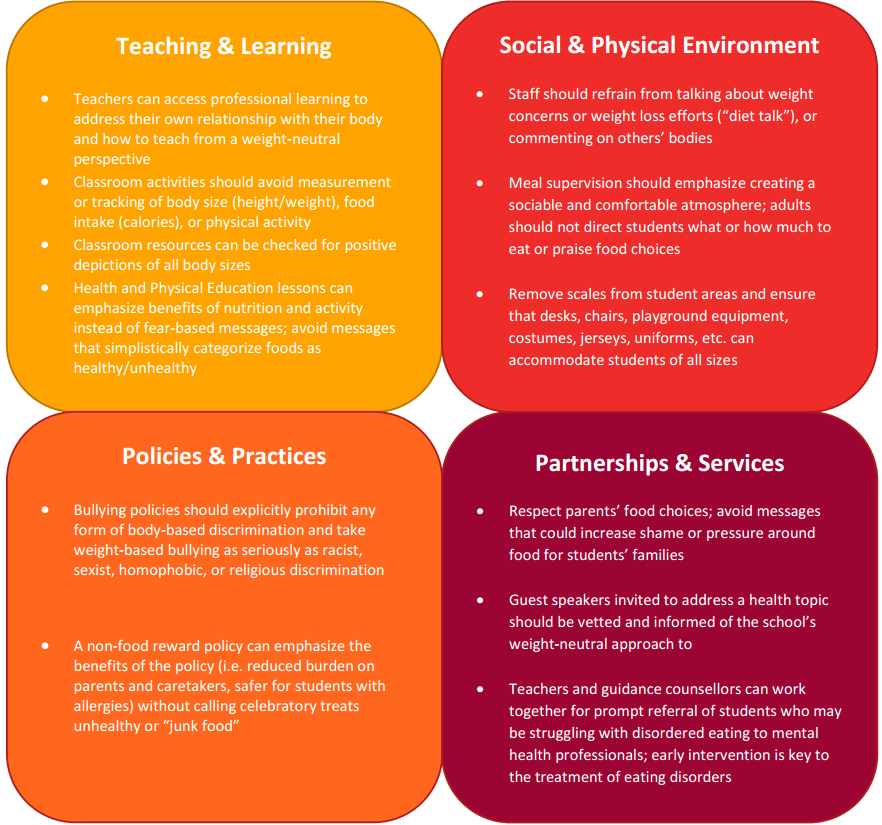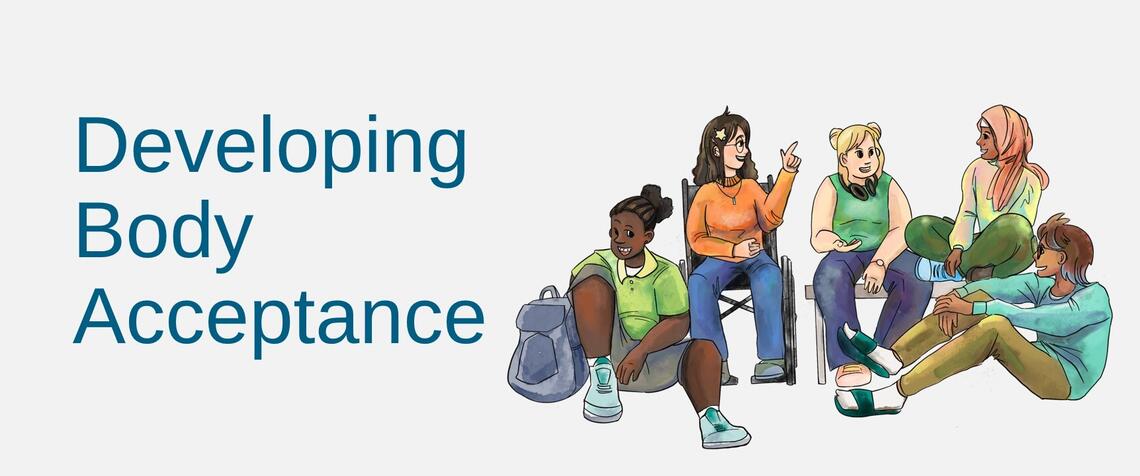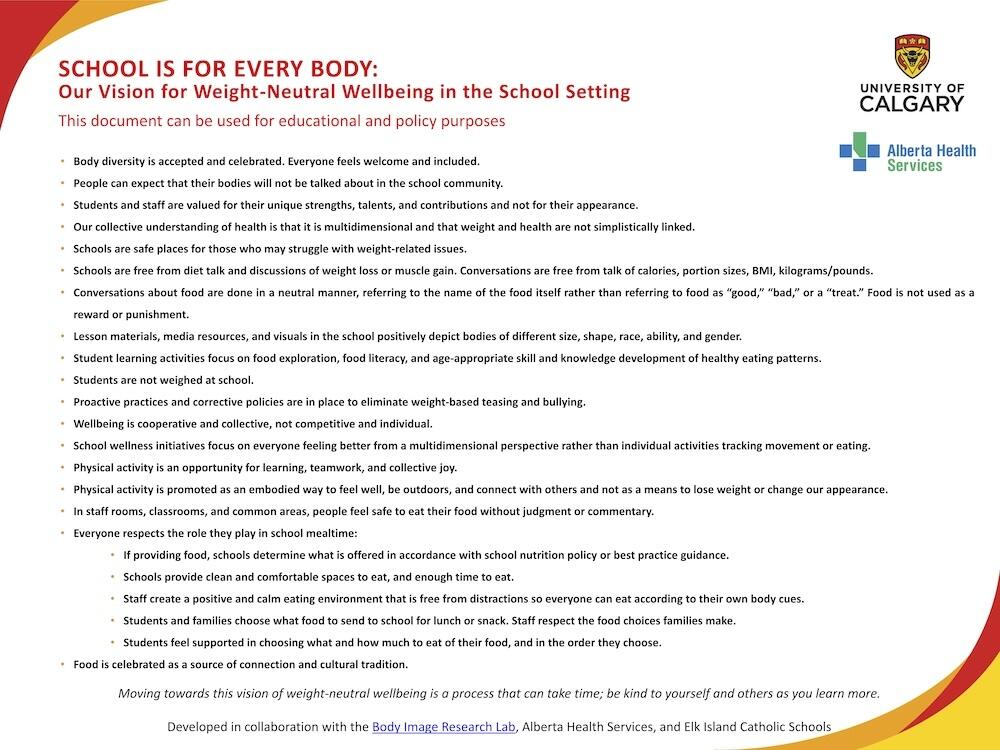Junior High Body Image Teaching and Learning Resources Available to Pilot!
The Body Image lab recently collaborated with AHS Nutrition Services to develop teaching and learning resources focused on body image for Grades 7-9. These materials take a weight-neutral and eating disorder safe approach to learning outcomes related to body image. Please check out these resources and share your feedback.
- Body diversity is accepted and celebrated. Everyone feels welcome and included.
- People can expect that their bodies will not be talked about in the school community.
- Students and staff are valued for their unique strengths, talents, and contributions and not for their appearance.
- Our collective understanding of health is that it is multidimensional and that weight and health are not simplistically linked.
- Schools are safe places for those who may struggle with weight-related issues.
- Schools are free from diet talk and discussions of weight loss or muscle gain. Conversations are free from talk of calories, portion sizes, BMI, kilograms/pounds.
- Conversations about food are done in a neutral manner, referring to the name of the food itself rather than referring to food as “good,” “bad,” or a “treat.” Food is not used as a reward or punishment.
- Lesson materials, media resources, and visuals in the school positively depict bodies of different size, shape, race, ability, and gender.
- Student learning activities focus on food exploration, food literacy, and age-appropriate skill and knowledge development of healthy eating patterns.
- Students are not weighed at school.
- Proactive practices and corrective policies are in place to eliminate weight-based teasing and bullying.
- Wellbeing is cooperative and collective, not competitive and individual.
- School wellness initiatives focus on everyone feeling better from a multidimensional perspective rather than individual activities tracking movement or eating.
- Physical activity is an opportunity for learning, teamwork, and collective joy.
- Physical activity is promoted as an embodied way to feel well, be outdoors, and connect with others and not as a means to lose weight or change our appearance.
- In staff rooms, classrooms, and common areas, people feel safe to eat their food without judgment or commentary.
- Everyone respects the role they play in school mealtime:
- If providing food, schools determine what is offered in accordance with school nutrition policy or best practice guidance.
- Schools provide clean and comfortable spaces to eat, and enough time to eat.
- Staff create a positive and calm eating environment that is free from distractions so everyone can eat according to their own body cues.
- Students and families choose what food to send to school for lunch or snack. Staff respect the food choices families make.
- Students feel supported in choosing what and how much to eat of their food, and in the order they choose.
- Food is celebrated as a source of connection and cultural tradition.
Moving towards this vision of weight-neutral wellbeing is a process that can take time; be kind to yourself and others as you learn more.
Developed in collaboration with the Body Image Research Lab, Alberta Health Services, and Elk Island Catholic Schools
Weight-Neutral Wellbeing in the School Setting
A Condensed Summary of Research and Recommendations by the Body Image Research Lab
Weight Bias and Diet Culture
Weight bias includes the negative attitudes, beliefs, and stereotypes about individuals with large bodies. Diet culture is characterized by a preference for thin bodies, moralization of weight, and a belief that thinness represents good health. Weight bias and diet culture beliefs can permeate all aspects of our lives, including health promotion efforts in schools that seek to improve the health of students through a focus on body weight. A weight-neutral approach considers various dimensions of health and is focused on choices and behaviours instead of weight. The weight-neutral approach is health-promoting and inclusive for all bodies.

Photo courtesy of UConn Rudd Center for Food Policy and Health
Weight-Centric Health Promotion in Schools Compromises Student Wellbeing
Because weight bias and diet culture are so commonplace in our culture, weight-centric messages can influence well-intended efforts to teach or promote health in the school setting. Research has repeatedly shown that the school setting is not an appropriate context for health interventions related to body size, and that messages that simplistically link health with weight are health-demoting. Teachers are more likely to struggle with disordered eating and eating disorders than the general population, and may not have been given specific training on the complex topics of nutrition or body image, which can all negatively impact health messages at school.
Unintended Harm: Reinforcement of Weight Bias
Weight is very complex, and influenced by numerous factors including genetics, culture, food environment, and physical activity. When health messages in the school setting suggest that a so-called “healthy weight” is completely under an individual’s control, weight bias in the school setting is unintentionally perpetuated, and students with larger bodies may experience greater stigma. Students of all sizes report bullying based on weight more frequently than bullying based on academic ability, physical ability, race, religion, or class. Weight-based bullying in the school setting teaches weight bias to both victims and bystanders and is associated with several negative physical and psychological consequences, including body dissatisfaction and disordered eating behaviours.
Unintended Harm: Eating Disorder Risk
Eating disorders are serious mental illnesses that arise from a complex combination of factors. Some students are more vulnerable to developing an eating disorder due to genetic factors, family environment, personality, or co-occurring mental conditions (i.e. autism spectrum disorder, ADHD, and anxiety). An emphasis on maintaining a “healthy weight” increases eating disorder risk even when the dangers of eating disorders are discussed in the classroom. Even very young students may have weight-loss goals that can distort their interpretation of health messages in school. Research has found that learning assignments that invite students to measure their weight/BMI or encourage the tracking of food, calories, steps, or other forms of exercise can prime vulnerable students for a disordered and unhealthy relationship with their bodies.
Read a student's perspective on how assignments and messages in Health can increase eating disorder risk in an essay Dear Health Teacher.
Recommendations for Practice: Weight-Neutral Approaches to Comprehensive School Health
A Comprehensive School Health approach considers the multi-dimensional wellbeing of all members of a school community and relies on four inter-related components related to health education and health promotion. The Comprehensive School Health framework is a useful tool for considering how to ensure health is promoted from a weight-neutral perspective in the school setting. While each school will have its own specific needs to address, the following suggestions are recommended for creating schools where all students can thrive.

References & Recommended Resources
This summary is based largely on the following publication:
Tingle, E., Saunders, J. F., Nutter, S., & Russell-Mayhew, S. (2023). Taking weight out of the equation: Unintended harms of weight-focused health discourse in schools. Journal of Physical Education, Recreation & Dance. https://doi.org/10.1080/07303084.2022.2146818
Read about a school district that we worked with to create a more body-inclusive environment: Healthy relationship with food and body
We also recommend the following seminal articles on the weight-neutral paradigm and summaries of current research for further reading: Bacon, L., & Aphramor, L. (2011). Weight science: Evaluating the evidence for a paradigm shift. Nutrition Journal, 10, 69. https://nutritionj.biomedcentral.com/articles/10.1186/1475-2891-10-9
Mauldin, K., May, M., & Clifford, D. (2022). The consequences of a weight-centric approach to health care: A case for a paradigm shift in how clinicians address body weight. Nutrition in Clinical Practice, 1-16. https://doi.org/10.1002/ncp.10885
Nutter, S., Ireland, A., Alberga, A. S., Brun, I., Lefebvre, D., Hayden, K. A., & Russell-Mayhew, S. (2019). Weight bias in educational settings: A systematic review. Current Obesity Reports, 8, 185-200. https://doi.org/10.1007/s13679-019-00330-8
O'Dea, J. (2005). Prevention of child obesity: 'First, do no harm.' Health Education Research, 20(2), 259-265. https://doi.org/10.1093/her/cyg116
Pinhas, L., McVey, G., Walker, K. S., Norris, M., Katzman, D., & Collier, S. (2013). Trading health for a healthy weight: The uncharted side of healthy weights initiatives. Eating Disorders, 21(2), 109-116. https://doi.org/10.1080/10640266.2013.761082
Piran, N. (2004). Teachers: On "being" (rather than "doing") prevention. Eating Disorders, 12, 1-9. https://doi.org/10.1080/10640260490267724


